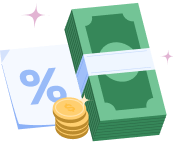Table of Contents
As the cost of groceries, gas, and rent goes up, more people are using credit cards to cover the daily costs. The little amounts can quickly accumulate, making simple payments in the form of debts beyond repair. Inflation increases the cost of living and also raises the cost of debt. This increases interest rates and payment terms.
Higher interest and larger minimum payments increase balances every month. Even something as small as a $20 purchase can end up costing much more later if unpaid. It’s a slippery cycle, and many aren’t even sure when they crossed the line from “managing expenses” to “stuck in debt.”
In this post, explore inflation and its impact on credit card debt, how to avoid pitfalls, and how Beem’s AI Wallet and Everdraft can be used to monitor spending. They can manage your debt before it spirals out of control.
Understanding the Link Between Inflation and Credit Card Debt
The inflation increases the daily expenses, and the income increases at a low pace. As essentials become pricier, many households use credit cards to cover the difference. This helps manage daily expenses but also leads to higher interest costs.
Credit cards usually have variable interest rates that shoot up when the Federal Reserve raises rates in response to inflation. This results in higher APRs. So inflation doesn’t just empty wallets at checkout, it quietly inflates interest charges too. And that double hit is what traps people.
How Inflation Fuels Credit Card Usage
People are relying more on credit cards to manage increased expenses. Gas, food, and utility bills, which used to be paid for in cash, are increasingly paid using cards.
Higher card usage drives up revolving balances. With rising interest rates, carrying balances becomes costly. For example, a $1,500 grocery purchase at 20% APR can accumulate hundreds in interest if not cleared.
Tools like category alerts in Beem help people to notice when they’re charging necessities on credit. This allows them to rework budgets and sidestep unnecessary debt.
The Hidden Cost of Rising Interest Rates
Most credit cards use variable APRs tied to the Federal Reserve’s benchmark rate. When the Fed increases rates to control inflation, interest costs on outstanding balances rise quickly.
For instance, a card with a 16% APR last year may now exceed 23%. This sudden jump can add significant financial pressure, especially on those carrying medium or large balances.
Using financial tracking apps to calculate the real cost of debt growth under changing rates helps maintain awareness and plan repayment effectively.
Inflation’s Effect on Minimum Payments
Minimum payments rise with increasing balances. Even minimal changes can extend repayment periods and increase total interest charges.
For example, a $2,000 balance with 23% APR and minimum payments could take years to eliminate. This might result in paying hundreds extra in interest. Making a little extra more than the minimum payment per month can reduce the time and interest paid.
Modeling repayment situations illustrates how modest, consistent increases in monthly payments save thousands in the long run.
The Psychological Trap — Normalizing Credit Dependency
Inflation changes how people perceive credit usage. Charging essentials to cards may feel like temporary survival, but over time, this mindset can normalize credit dependency.
Small bills seem manageable, but they quickly accumulate. Before long, several balances on various cards create a financial net that is difficult to break out of.
Monitoring periodic expenses such as groceries, gas, or utilities will break this cycle. It leads to budgeting rather than borrowing.
The Snowball Effect of Carrying Balances During Inflation
Balances are carried month after month and compound very quickly. When inflation and interest rates increase at the same time, even small balances increase unusually fast.
For example, a balance of $2,000 at 23% APR might result in more than $700 in interest per year if one just makes minimum payments.
Habit reminders and proactive payment plans assist in keeping balances under control earlier. This is less likely to result in a debt cycle, as well as less financial anxiety.
How Inflation Impacts Credit Scores
Inflation doesn’t just squeeze wallets — it affects credit health too. When spending goes up and repayments stay slow, utilization rates climb. And high utilization, even without late payments, signals risk to lenders.
- Even small unpaid amounts grow faster under inflation, affecting score calculations.
- Managing several accounts during inflation raises the chance of errors or missed payments.
- Without tracking, it’s easy to lose control over spending and repayment priorities.
Beem’s AI Wallet helps by showing exactly how much credit is used, sending reminders for bills, and highlighting where inflation impacts finances most, turning financial chaos into clear, manageable actions.
Inflation’s Indirect Hit — Fees, Penalties, and Credit Fatigue
Inflation increases daily expenses. It also increases the possibility of late charges, over-the-limit fees, and account closures as individuals are unable to pay their bills.
Carrying multiple credit cards can be challenging in times of financial strain. Missed payments and forgotten balances are easy to make. Small errors quickly escalate into accumulating debt and stress.
Beem’s reminders and automation assist by keeping financial monitoring in one spot. Users get timely reminders for payments, transparent spending insights, and fee support.
Why Credit Card Debt Feels Harder to Escape During Inflation
Inflation makes credit card debt feel heavier, even when wages increase slightly, because higher living costs absorb most income gains. Here’s why:
- Inflation eats away at disposable income. Groceries, rent, and gas cost more of your money.
- Small salary increases translate to smaller amounts of money available for debt repayment when inflation is taken into account.
- High APRs and increasing balances translate to minimum payments being largely spent on interest, hindering debt paydown.
Tools such as Everdraft provide immediate, no-interest assistance for vital bills. This helps consumers save for emergencies without adding to their credit card debt; therefore, they can regain financial control.
The Emotional Burden of Inflation-Driven Debt
When credit card balances keep rising due to inflation, it often creates silent stress. Many people begin to feel anxious or guilty about their spending, and this emotional pressure can lead to avoiding bank statements altogether just to escape the worry.
Constant financial strain also affects judgment. Decisions under stress are reactionary. Borrowing appears to be the easiest way to get relief, even though this means more debt down the road.
Beem’s AI Wallet facilitates the break from such thinking. It offers transparency, highlights trends, and offers peaceful and factual recommendations.
Practical Ways to Manage Credit Card Debt During Inflation
It can be challenging to handle credit card debt in times of inflation, and some measures can be used. Here are some practical methods of dealing with your debt:
1. Pay More Than the Minimum
Paying an additional $25 per month can prevent balances from increasing and save on interest charges in the long run.
2. Prioritize High-Interest Balances
Prioritize paying cards with the highest APR first. This makes you money and gets you debt-free faster.
3. Negotiate Interest Rates
Call your card issuer for lower rates if you have a good payment history and track progress in Beem.
4. Avoid “Buy Now, Pay Later” Pitfalls
These services act like credit cards, often with hidden fees or interest, increasing costs during inflation.
These strategies don’t demand a lifestyle change, just small shifts in order and timing, which matter more than people realize.
Smart Budgeting Habits to Avoid Future Credit Dependency
Inflation can fluctuate; however, smart budgeting behaviors can bring some stability and prevent situations in which a person can use credit cards. Here are some of the smart habits that can be adhered to:
1. Separate Fixed and Flexible Expenses
Separate the necessities, such as rent and food, from the luxuries, such as entertainment. This facilitates spending control.
2. Automate Bill Payments
Automate the bill payment system. This will prevent late charges and unwarranted interest levies.
3. Track Spending Closely
Monitor every purchase to see where your money goes. This ensures you don’t overspend on small, repeated expenses.
4. Use Beem’s Insights
Beem reveals where you are spending the most and the effect of inflation. This converts confusing money into understandable, easy-to-handle information.
Building these habits gives you financial clarity. They lower your reliance on credit and keep you in control in times of increasing expenses.
How Beem Helps You Take Control of Credit Debt During Inflation
Credit card debt is not easy to control in times of inflation. Nevertheless, the appropriate tools can make it easier. Here’s how Beem helps you manage your credit card debt:
- AI Wallet: It monitors your spending and credit utilization in real time. This means that you get to know where your money goes.
- Everdraft: This provides you with instant, interest-free cash for unexpected expenses. You can pay bills without accumulating more debt.
- Beem Pass: It gives cash back on daily necessities. This minimizes your dependence on high-interest credit cards.
With Beem, you get a smarter, interest-free solution to debt. Even when prices increase, you can be organized and be able to make smart financial decisions.
FAQs on Inflation and Its Impact on Credit Card Debt
Why does inflation make credit card debt more expensive?
The rate of inflation is known to drive the Federal Reserve towards raising interest rates. When the rates are higher, credit card APRs also rise. This increases the costs of paying a balance.
How can I reduce my credit card debt faster during inflation?
Offset the minimum balance and give more priority to higher interest cards, and keep a check on your expenditure. Tools like Beem AI wallet help to keep track of balances, repayment schedules, so that your debt is also paid off at a faster rate despite the increasing costs.
Should I close credit cards to avoid spending during inflation?
Closing credit cards may reduce your overall credit limit and damage your credit score. Rather, control your consumption, settle bills on time, and allow financial space to prevent avoidable debts.
What’s the best alternative to using credit cards for emergencies?
Short-term zero-interest facilities such as Beem’s Everdraft deliver immediate cash for immediate needs. This guarantees that you will not end up in huge credit card debt with high interest rates, and at the same time, you will not lose financial stability in case of inflation.
How can Beem help me stay on top of my debts?
Beem monitors your credit card usage, sorts out costs, and reminds you about the payments. This automation will save you from missed deadlines, late charges, and you will know how much your interest is growing, and it is easy and stress-free to manage debt.
Conclusion — Taming Debt Is the Key to Beating Inflation
Inflation is temporary, but good debt management can ensure long-term stability. It is important to know the effect of inflation on credit card debt. Financial stress can be minimized by being disciplined in terms of payments and budgeting.
Beem assists people in tracking their expenditure, debt management, and has access to interest-free funds during emergencies. By managing debt actively, users keep control, protect their credit score, and lower long-term interest costs.
Download Beem today to manage debt smarter with AI Wallet and Everdraft, and take steps toward financial freedom even during inflationary periods.
















































